Eliminating measles and rubella from India
On any Rotary platform when statistics are being discussed vis-a-vis polio, a set of impressive numbers are given to show the impact Rotarians have made by getting most of the world rid of polio. Prior to Rotary’s PolioPlus programme, 350,000 children in 125 countries were being crippled by polio every year. And today 2.5 billion children are being immunised against polio thanks to this programme. And so on.
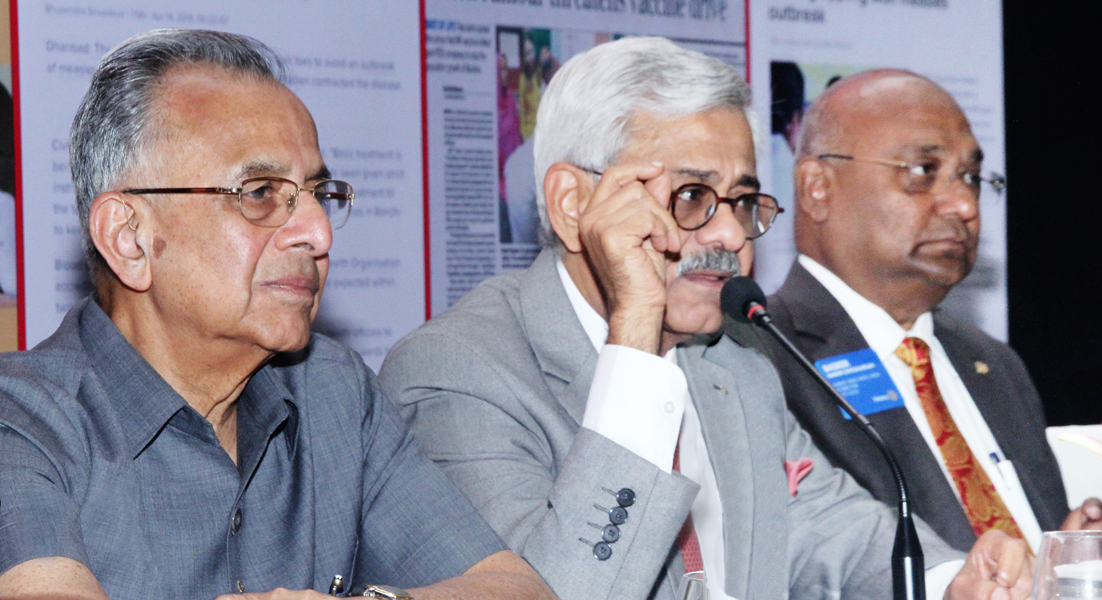
But Chairman of the India Expert Advisory Group of Measles and Rubella, Dr Jacob John, who has played a pioneering role in the launch of the PolioPlus programme by Rotary, quoted a startling number at the National PolioPlus and MR (Measles — Rubella) Orientation meet held in Delhi in August. He said that keeping in mind how some health officials had believed that it was unjustifiable to spend so much money, or force governments to spend so much money, on attempting to eliminate polio, a detailed economic analysis was done in 2014, and the economic benefit of eradicating polio from almost the entire world, bar three countries, was stupendous.
Dr John said that according to the World Bank, some $2 billion or ₹14,000 crore (at present dollar rate) had been spent by the GoI on the polio eradication programme in India. “Add to this another ₹10,000 crore, the money that we Rotarians spent from our pockets on campaign material and other expenses, and the upper limit of what we spent on the polio drive totals ₹24,000 crore.”
But the 2014 study showed that the economic gain from eliminating polio from India is $1.71 trillion. Taking 2012 as the cutoff year, “we have created ₹1,197 lakh crore (at present conversion rate) of wealth by eradicating polio. Let us at least be aware that the huge effort we invested in polio has made India richer. Others may not realise this and not give Rotary credit but we must know that we Rotarians have contributed substantially to the socio-economic development of India. We should examine how the low-hanging fruit of disease elimination brings about huge socio- economic development in the process.”
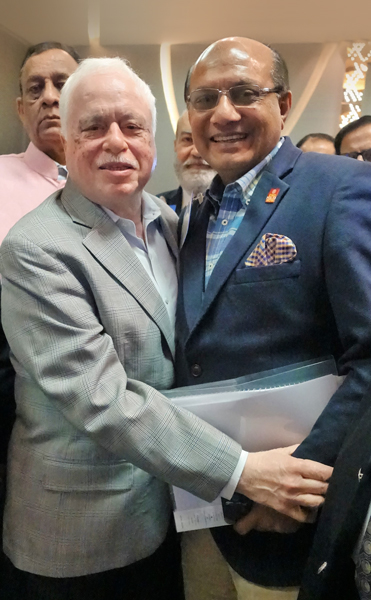
Now that Rotary in India had decided to join the Government’s National Immunisation programme to increase the cover of routine immunisation with the focus being on eliminating measles and rubella by 2020, Rotarians will have to gear up for this journey. “Please learn the name of Measles and Rubella in your local languages. Then you will be able to communicate properly to your communities about the dangers both measles and rubella pose (see box). Before vaccination began, one per cent of urban children and three per cent of rural children died due to measles and its complications,” he added.
The low-hanging fruit of eliminating diseases such as polio brings about huge socio- economic development in the process.
– Dr Jacob John
Spelling out the immense danger that the unborn child faced if a pregnant woman contracted rubella, Dr John said that “the baby can develop brain, heart, eye, bone and other diseases congenitally and some might think it is better that such a severely handicapped baby dies rather than lives with such insurmountable difficulties.” Also, in this case of MR vaccination, the scene is complicated. The first MR vaccine is introduced in school-based campaigns, covering all children up to 15 years. In parallel, community-based campaign covers all children from 9 months to 4 years plus the non-school going ones. Why 15 years? “It is a complicated situation but we want all the girls under 15 given rubella vaccination, so that even if the rubella virus survives in the community, young mothers will not get rubella,” he said.
“Did you know that Rotary introduced measles immunisation in India? In 1978 when the immunisation campaign was introduced in India, measles was not included because the vaccine was expensive and not even licensed in India.” In 1979, D 3230 (Tamil Nadu) got special permission from the GoI to vaccinate children in the State against measles “thanks to our dear late MGR (former TN Chief Minister M G Ramachandran). And we got nearly four million doses of vaccine donated by Canadian Rotarians, and in partnership with the TN Health and Family Welfare Ministry, we virtually stopped child deaths due to measles in the State in five years!”
This experience, added Dr John, led the health ministry to get the licence for the measles vaccine in 1984 and introduce it in the EPI, (Expanded Programme on Immunisation), which was later renamed Universal Immunisation (UI).
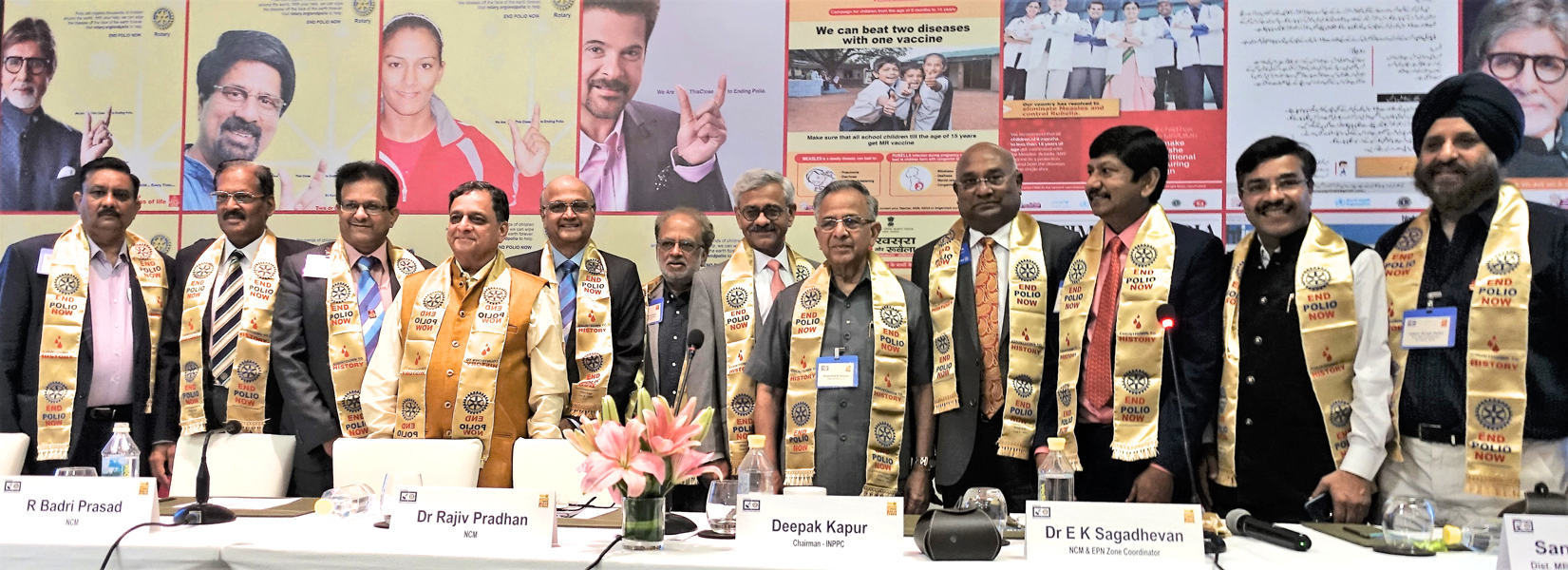
Addressing the meet, Past RI President Rajendra Saboo marvelled at the journey Indian Rotarians had made in eradicating polio from India. “At one time the world thought India would never be able to eradicate polio. And if India can’t do it then the world could never be polio-free, it was said. On the day India was declared polio-free, it wasn’t just India but the entire Rotary world, WHO, UNICEF and all our global partners celebrated the event.”
He recalled that at one time “the government rejected the idea of NID and said we will do it our own way. And how Rotary did advocacy at the highest level and how the policy of national immunisation days was adopted, is part of history. But our dream would not have been achieved without the government sitting on the driving seat. That was our biggest achievement. Yes, success has many fathers and many people will take credit for it.”
Turning his ire on the Rotarians in the gathering who kept complaining that Rotary had not been given due credit for eradicating polio from the world bar three countries (Nigeria, Afghanistan and Pakistan), and implying that the same would be true of Rotary’s involvement in the GoI’s Universal Immunisation programme, Saboo said: “To be very honest, what have we done so far where measles and rubella are concerned? Resolve is one thing, action is another. We signed an MoU a year ago but then there has been no action. We have to have active participation and involvement and then we can rightly get the credit.”
We promoted polio campaign more through traditional media, but now false information is spread through social media, particularly Whatsapp messages.
– Dr Pradeep Haldar
Advising the assembled DGs, PDGs and others involved in the MR immunisation drive to first arm themselves with knowledge about the dangers of both measles and rubella, Saboo said this was Rotary’s trump card in polio and it should be followed. “When we started on the dream to rid the world of polio, it seemed so easy. The estimate was that we would require just $120 million to immunise the children of the world. We thought we’d be able to achieve our goal by 2005. So willy-nilly Rotary got into what it thought was a simple task.”
But once India had eradicated polio a good deal of “complacency” had crept into Rotary and involvement in routine immunisation had waned. But we can’t afford to forget that the virus is present in our neighbourhood and could cross the borders anytime. “Also, there are pockets here in India where polio can appear any moment.”
But apart from being vigilant on the return of polio, Rotary needed a new challenge… “a new thought to capture the imagination of Rotarians”.
Touching upon the ‘Plus’ in the PolioPlus programme, Saboo recalled that in 1984–85, when Rotary approached its partners such as WHO, it was decided that while Rotary would take care of the polio immunisation, other communicable diseases — the ‘Plus’ part — would be handled by WHO. But by 1988 both WHO and UNICEF started concentrating on polio and the ‘Plus’ part was sort of neglected. It however remained in government immunisation programmes.
On the day India was declared polio-free, it wasn’t just India but the entire Rotary world, WHO, UNICEF and all our global partners celebrated the event.
– Past RI President Rajendra Saboo
Now that Indian Rotarians needed a “new challenge” both he and Past RI President Kalyan Banerjee had managed to convince the International PolioPlus Committee, RI Board and TRF Trustees that Indian Rotarians can now take up the ‘Plus’ part and get involved in India’s UI programme. “We told them we are not asking for any money, we will find it ourselves and they said we will support you in your admin cost but the money collected for polio cannot be diverted as long as polio continued anywhere in the world.”
Urging Rotarians to be vigilant on the return of the polio virus, Saboo said, “Rekindle the spark in your districts and clubs and motivate them to participate with the greatest enthusiasm in the MR immunisation. If you don’t do that, we will fail. But if we do, then I can assure you that this experiment of MR that India has been allowed by RI to incorporate in the PolioPlus programme can be replicated in rest of the world.”
In his address, TRF Trustee Gulam Vahanvaty stressed on “complete eradication of polio” being Rotary’s highest external priority; “this can’t be stressed enough. We’ve got to be on our toes and work wholeheartedly to ensure that if we are this close, we have to close it completely. We have to reach 100 per cent.”
Thanking D Ravishankar, President of RC Bangalore Orchards, for his magnanimity in donating ₹100 crore (about $14.7 million) to the Foundation, he complimented RID 3190 DG Suresh Hari for convincing the Rotarian to make this huge donation. “Now both Hari and Ravishankar are working on fine tuning the details of how that ₹100 crore is to be used.”
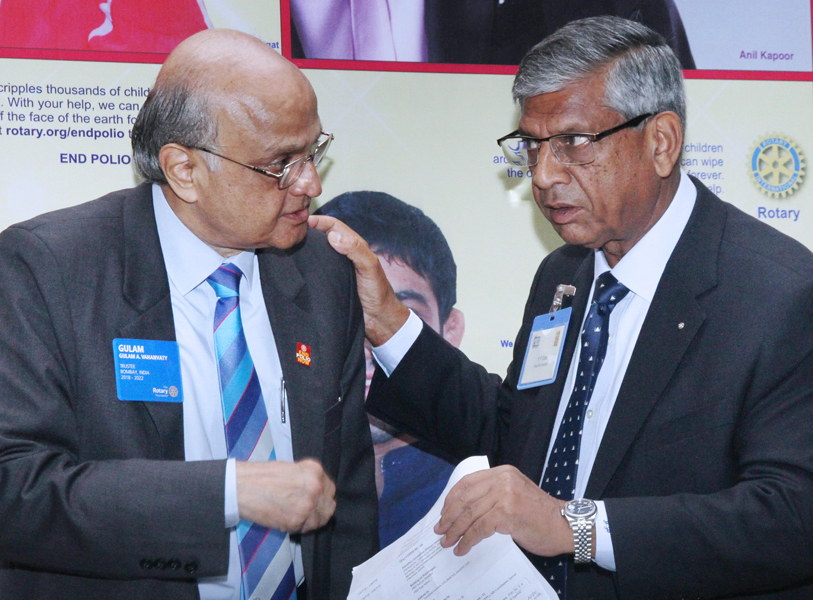
Vahanvaty added: “Of course this has changed the goal for every district governor in our country. My own DG Shashi Sharma who had given a goal of $7 million, will now have to add many more ‘7s’ to that figure because he has to be higher than District 3190! And the same goes for DGs from across the country who have been motivated by this one donation to go for higher goals.”
He urged the assembled Rotarians to “work with the same commitment and zeal not only to ensure that India remains polio-free but also to eradicate measles and rubella.”
Earlier addressing the meeting, PRID Ashok Mahajan said it took less than $2 to vaccinate a child against measles and rubella. “We know it is not an easy task, but it’s not impossible. We have the experience of polio, which was difficult task too. In those 30 years we struggled and had many stumbling blocks and so much resistance, but every problem was solved. We can also rid India of MR if you work with the same enthusiasm.”
But funds to the tune of ₹5 crore were required in this fight against MR. “For polio eradication we had TRF to support our cause but this is our own programme and funds have to be generated, not an impossible task. If each RI district in the zone raises ₹12 lakh, our target will be met,” he added. If his help was required he would always be available to talk to corporate or individual donors, as also to religious leaders if resistance to the immunisation was seen in any pocket, as had happened during polio too.
It’s not an easy task, but not impossible. We have the experience of polio; in those 30 years we struggled and had many stumbling blocks and resistance, but every problem was solved.
– PRID Ashok Mahajan
Addressing a session on Wash in Schools, RIPN Designate Sushil Gupta urged the DGs and other Rotary leaders in the hall to continue to work with enthusiasm on the preventive aspect of combatting infections and diseases. And that is hygiene and sanitation. “Please continue to work in schools to ensure that the children wash their hands with soap and water adequately, particularly before taking their food, and after using a toilet.” Work on building group handwashing stations and separate toilets for girls and boys should continue, “as we will have to focus our attention and energy on the younger generation to bring about behavioural change. Once we change their mindset, and through them their families’ and entire community’s mindset, so many preventable diseases can be tackled.”
Similarly, attention should also be paid to ensuring menstrual hygiene for adolescent girls by giving them privacy through separate toilets with adequate water supply. By doing this, Rotary will be ensuring education for a generation of girls, who otherwise tend to drop out of secondary schools for lack of basic and hygienic toilet facilities.
INPPC Chair Deepak Kapur cautioned the gathering that Indian Rotarians could not afford to relax on polio immunisation till the entire world was rid of polio. “Let us not forget that polio has gone from India but not the world… polio immunisation is as relevant today as it was in the yesteryears. As of today 13 cases of polio have been reported and the main reason for the Delhi meet was to evolve a strategy to use “our polio legacy” for GoI’s UI programme.”
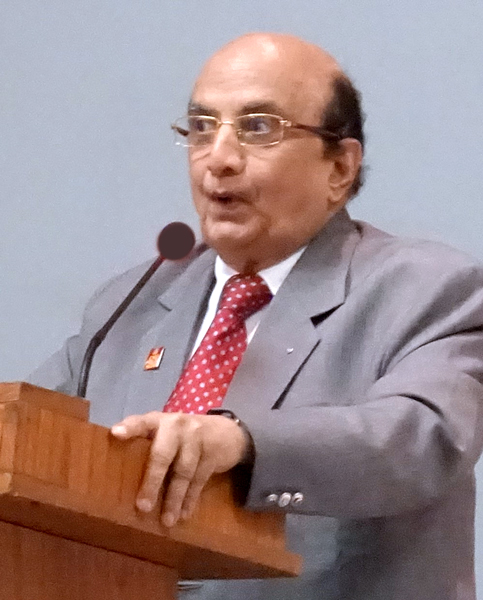
The genesis of Rotary’s involvement in MR can be traced to the presentation that Dr Jacob John had made to senior Rotary leaders as the chief of the India Expert Advisory Group on MR, he added.
Referring to the humungous size of the polio immunisation events in India, he said on NIDs “we have 700,000 polio booths, 25 lakh vaccinators, 22.5 crore IVP doses… This happens on every NID and during the End Polio Now campaigns Indian Rotarians have proved that you have the energy, capacity and now the confidence to scale up our efforts and rid India of other communicable diseases such as measles, rubella, TB etc. And you can raise the funds needed; if a single Rotarian can give ₹100 crore to our Foundation, just imagine what we can do collectively.”
Kapur also urged Rotarians to involve Interact clubs to make schools accept the MR programme. “And please also make use of the offer made by the champion of the Ulemas, PRID Mahajan, to overcome resistance, if any, in your region. He will be happy to help to protect our children.”
PRID Yashpal Das addressed the Rotarians on the “road ahead” and urged them to leverage the experience and infrastructure they had developed from the polio eradication programme in India and extend it to protect our children against measles, rubella, TB and other communicable diseases by their total and passionate involvement in the MR programme.
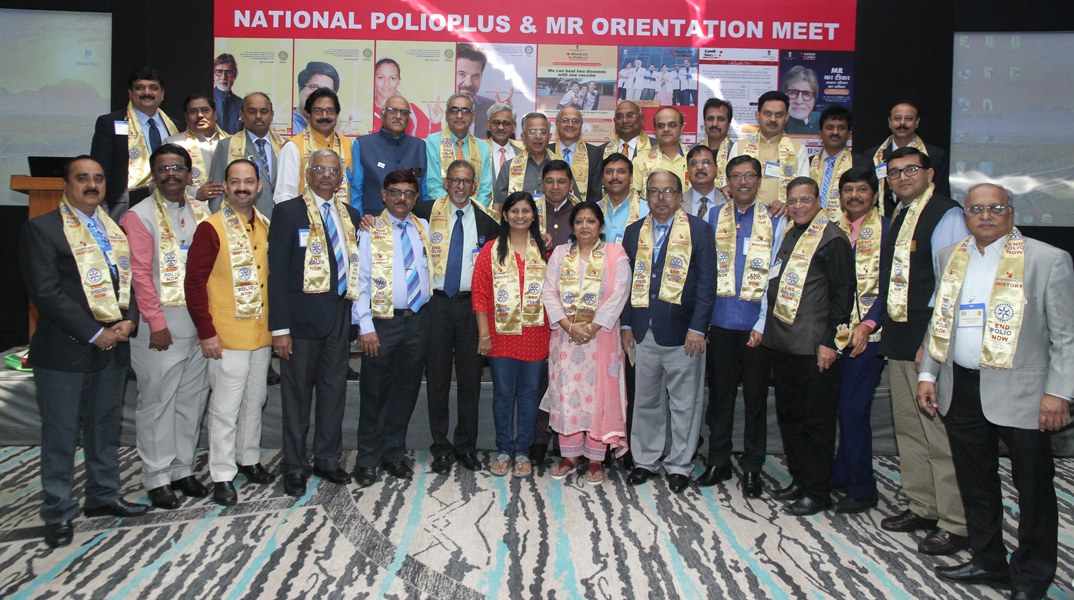
Dr Pradeep Halder from GoI’s Health Ministry said in the GoI’s MR immunisation programme, vaccination for viral diseases such as measles and rubella has got the highest priority. “In polio we had to vaccinate almost 17 crore children, here the number is higher at about 40 crore as it is a much higher population in the age group nine months to 15 years. Also this is an injectable vaccine so we can’t have as much flexibility as we had in polio.”
The MR campaign will be carried out through hospitals, health centres, sub centres, etc “and we will use different strategies to reach all sections of the community. In the first week, we try to target schoolchildren as they form nearly 70 per cent of our population. So we begin with schools and then go to the rest of the community.” But there were challenges in getting 100 per cent coverage, such as “inaccurate information, misconceptions and rumours spread through the social media. “Even in polio, we had encountered such problems but in those days we had promoted the polio campaign more through traditional media, but now a lot of false information is being spread through social media, particularly WhatsApp messages.”
As the primary target group was schoolchildren the involvement and cooperation of teachers and principals was important. But coverage in private schools was more a challenge than public schools. Engagement with religious leaders, particularly in madrasas, was very important, he said.
We have 700,000 polio booths, 25 lakh vaccinators, 22.5 crore IVP doses…This happens on every NID.
– INPPC Chair Deepak Kapur
A mistake in the first phase of the MR campaign was that “unlike in polio, we did not involve celebrities like Amitabh Bachchan, but now we have made him the face of this immunisation campaign.”
While many States have already been covered, the bigger States like UP, Bihar, Maharashtra, West Bengal, Rajasthan and Madhya Pradesh will be taken up in November. To make the programme a success “high quality campaigns and partnerships are required” and Rotary’s participation and partnership were very important, Dr Haldar added.
PRID Yashpal Das and PDGs Rajiv Pradhan and Anil Agarwal were given awards for their special contribution in the End Polio drive.
In his address, Dr Danesh Ahmed, Technical Officer (Immunisation), WHO, highlighted serious concerns on the missing children in some pockets of India and the slow progress of immunisation in urban areas, particularly slums.
Acknowledging Rotary’s tremendous contribution in making India polio-free, he recalled the time he wasn’t even able to meet or convince the district magistrate in Noida about the importance of immunisation. “Thanks to Rotarians who met and convinced him, he now chairs the district immunisation meetings.”
Rtn D Ravishankar giving ₹100 crore to TRF has changed the goal for every DG. My own DG Shashi Sharma’s original goal of $7 million, will now need to get many more ‘7s’ in that figure because he has to be higher than District 3190!
– TRF Trustee Gulam Vahanvaty
Similarly, between 2005–10, the polio immunisation programme had run into rough weather in Moradabad with huge opposition from the Muslim community. “We were trying to engage religious leaders and influential persons in the community, but without much luck. But then came Rotary with its ulema committee, and took the initiative to organise the meeting of such leaders. The way the Rotary ulema committee engaged and motivated the people and provided a solution is unprecedented. On no other occasion than such polio meetings, people of different faiths spoke the same language and conveyed the same message.”
Right now intensive MR immunisation work is going on in Haryana and over 90 per cent coverage has been achieved. But in two districts, including Mewat, again a similar resistance is coming from the minority community, and “we have to once again bring them on board before we start the immunisation in bigger States like UP, Bihar and Maharashtra.”
Stressing the need for cent per cent coverage in MR immunisation, PDG Rajiv Pradhan urged the Rotary leaders in the hall to “treat the operation manual given in your kits as your Bible or Gita as all the details are given there.” It explained why children were missed… awareness gap, the child travelling etc. While there is a huge group not getting any doses at all, some get only one or two doses. “This is our major challenge.”
Pictures by Rasheeda Bhagat and Hemant Kumar Banswal
Measles is “mini AIDS”
At RI’s National PolioPlus and MR Orientation meet in Delhi, eminent virologist and Chairman of the India Expert Advisory Group (IEAG) on MR, Dr Jacob John made a startling revelation which equated measles to “mini AIDS”. “For every child who got polio in the past, one child also died of measles. But those children are not alive to tell their story.” He said there have been a lot of measles-related deaths that have not been categorised or recognised as measles related, because measles brings with it a lot of complications… diarrhoea, dysentery, rain fever and several other complications which arise due to measles… which kill the child within a year of getting measles.
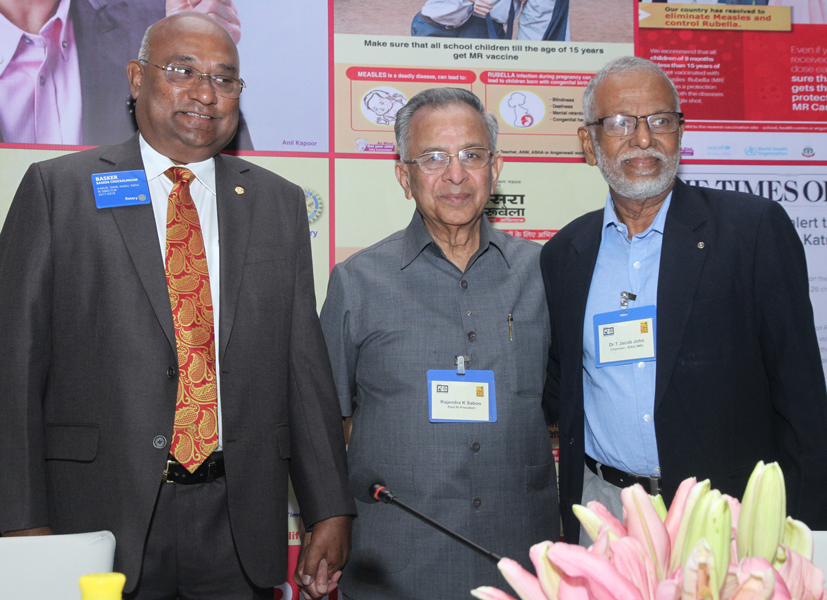
“But we understand today that measles is mini AIDS. It suppresses your immune system and it takes two to three months for 90 per cent recovery and two to three years for 99.9 per cent recovery. So during this period of two years the children are still dying of diseases they wouldn’t have had without getting measles. This is the tip of the iceberg… that’s why I use the term that eradicating measles is the low-hanging fruit for social development.” There are no health economists who calculate the loss or long-term effects caused by measles-related complications but “please believe me, this is a terrible disease that is best got rid of.”
The only sure way of keeping measles under control, Dr John added, is to “get rid of the virus, as we got rid of the polio virus from the community.”
Coming to rubella, he said that if we underdid rubella vaccination and let this virus survive in the community, “it will infect a pregnant woman. So if you don’t do a good job and slow down the spread of rubella virus in the community by underdoing your immunisation, then more girls will survive without either vaccine or the disease immunity, so you can actually, paradoxically and theoretically, increase the risk of congenital rubella syndrome if you botch up this programme.”
That’s why the Government of India was so careful in balancing the availability of the vaccine and aiming for 100 per cent coverage. “The coverage has to be as high as we can achieve for we don’t want children below 15 surviving without immunity, adding to the paradoxical and theoretical increase of rubella in future. We have to remove the virus to protect the unprotected women in the future,” he added.
